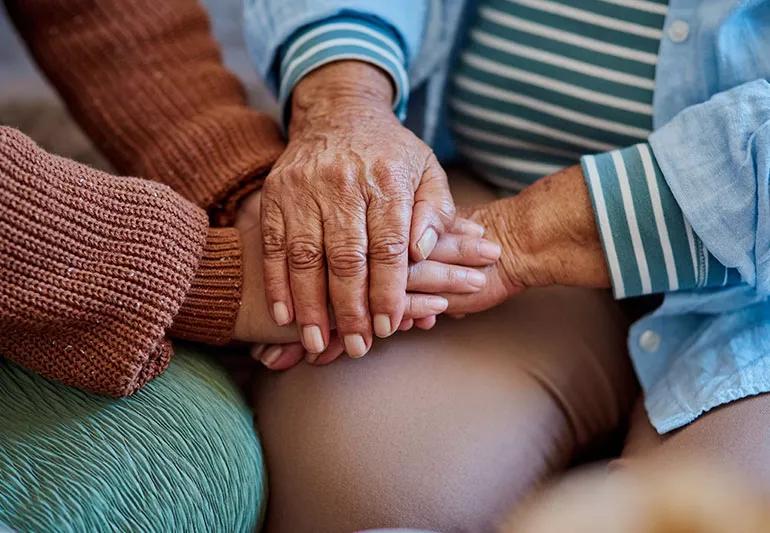Understanding ambiguous grief is often a challenging process due to its nature of being unclear and uncertain. This type of grief occurs when there is a loss that is not socially acknowledged or accepted, such as the end of a relationship, infertility, or the loss of a pet.
It can also occur when a loved one is physically present but emotionally distant, such as those suffering from dementia or addiction. It is characterized by confusion, unresolved emotions, and a lack of closure. Grieving individuals often find it hard to articulate their feelings, leading to isolation and a sense of being misunderstood.
Starting to heal from ambiguous grief is a journey that involves acknowledging the loss, understanding the complexity of emotions, and seeking professional help if necessary. It is crucial to recognize that this type of grief is real and valid, even though society might not acknowledge it. Accepting the loss can be challenging, especially when the loved one is physically present but psychologically absent. However, acceptance is a critical step towards healing.
Emotions associated with ambiguous grief are often complex and multifaceted, involving a mix of sadness, anger, confusion, guilt, and regret. It is essential to allow oneself to feel these emotions fully rather than suppressing them. Journaling can be a helpful tool in expressing and understanding these feelings. It allows one to articulate their thoughts and emotions, providing a form of release and relief.
In some cases, seeking professional help can be beneficial in navigating the complex journey of healing from ambiguous grief. Therapists and counselors can provide valuable guidance and support, helping individuals process their emotions and develop effective coping strategies. They can also provide a safe and non-judgmental space for individuals to share their experiences and feelings.
Support from loved ones is also crucial during this time. It is important to communicate openly about the grief and ask for understanding and patience. Loved ones might not fully comprehend the nature of ambiguous grief, but their emotional support and empathy can make a significant difference.
Engaging in self-care activities is another crucial aspect of healing. This can involve taking time for relaxation, pursuing hobbies, maintaining a healthy lifestyle, and practicing mindfulness or meditation. Such activities can help reduce stress, promote emotional well-being, and aid in the overall healing process.
Lastly, joining a support group can be beneficial. Meeting others who are going through similar experiences can provide a sense of community and reduce feelings of isolation. It allows individuals to share their experiences, learn from others, and gain hope and strength.
In conclusion, understanding and healing from ambiguous grief is a unique and personal journey. It involves acknowledging the loss, understanding emotions, seeking professional help, communicating with loved ones, practicing self-care, and potentially joining a support group. It is a process that takes time, patience, and resilience, but with the right resources and support, healing is possible.
Grieving a Loved One Who Has Changed, Not Died
Grieving a loved one who has transformed dramatically, rather than passed away, can be a profound emotional journey. Although the person physically remains with us, their change in personality or behavior can be so drastic it feels as if we’ve lost the individual we once knew.
This could be due to a variety of factors such as addiction, mental illnesses like Alzheimer’s or dementia, traumatic brain injuries, or even personal choices that fundamentally alter the person’s identity.
In these circumstances, the familiar characteristics, shared experiences, and emotional connections that were once present may no longer exist, leading to a sense of loss. You might feel a confusing mix of emotions – sadness, frustration, anger, and even guilt, questioning if there was something more you could have done to prevent this transformation.
As with any form of grief, it’s important to allow yourself to experience these feelings rather than suppressing them. Acknowledge the pain that comes with this unique form of loss and seek support from trusted friends, family members, or professional counselors.
It’s also crucial to remember that this change in your loved one is not a reflection of your relationship with them or any actions on your part. The person you knew might not exist in the same way, but it’s okay to mourn that loss while still caring for the individual they’ve become.
This form of grief, often referred to as ‘ambiguous loss’ or ‘living grief’, is an ongoing process without a definitive end. It’s a challenging path, but by embracing your feelings, seeking support, and practicing self-care, you can navigate through this difficult experience.
Healing from an Unnamed Pain
Healing from an unnamed pain is an arduous journey that requires immense courage and resilience. It’s a silent battle, often fought alone, against an invisible enemy that leaves no physical marks, but wounds the soul deeply. This pain is shrouded in mystery, unknown and unspoken, making it more challenging to address and overcome. It often arrives uninvited, leaving an individual feeling vulnerable and isolated.
Despite this, healing is indeed possible. It’s a process that demands patience and perseverance, acceptance and self-love. It starts with acknowledging the existence of this pain, even if it remains unnamed. It’s about understanding that it’s okay to feel hurt and it’s okay to seek help. One crucial step towards healing is unveiling the pain, giving it a voice, and sharing it with someone trusted. It could be a confidant, a therapist, or even a personal journal. Expressing the pain helps to loosen its grip, making it less overpowering.
Another significant aspect of this healing process is self-care. It’s about nourishing the mind, body, and soul through healthy habits and positive thinking. Practicing mindfulness, indulging in hobbies, maintaining a balanced diet, and regular physical exercise can be beneficial.
Remember, healing doesn’t mean the pain never existed. It means the damage no longer controls our lives. As we heal, we transform, becoming stronger and more resilient. The unnamed pain, once a crippling enemy, becomes a catalyst for personal growth and development.
We learn from it, we grow with it, and we become better versions of ourselves because of it. In the end, we emerge victorious from the battle against the unnamed pain, carrying the proud scars of a survivor.

Steps to Heal from Ambiguous Grief
Ambiguous grief is a unique type of sorrow individuals experience when they endure a loss that is not socially acknowledged or validated, such as the end of a relationship, loss of health, or miscarriage. Healing from this form of grief involves several crucial steps. The first step is recognizing and acknowledging the loss.
This might sound simple but it is often difficult as the loss may not be physical or tangible. The individual must give themselves permission to grieve regardless of societal norms and expectations. The next step involves expressing the grief. This can be accomplished through various outlets such as writing, painting, or even talking about it with a trusted friend or therapist.
Further, it is beneficial to seek support from those who empathize with the experience. Connecting with others who have undergone similar losses can provide a sense of understanding and validation that one is not alone. Another important aspect is self-care.
This involves ensuring adequate sleep, a balanced diet, regular exercise, and engaging in activities that bring joy or relaxation. Finally, it is crucial to remember that healing is not linear; it is okay to have good and bad days. It is a journey that entails patience and self-compassion.
Over time, the intensity of the grief will lessen, and the individual will learn to live with the loss, transforming their sorrow into resilience. These steps are not definitive as everyone grieves differently, but they provide a framework that can guide an individual through their healing journey. Remember, it is always okay to seek professional help if the grief becomes overwhelming.
Recognizing Activating Events in Grief
Recognizing activating events in grief is a significant aspect of the healing process. Activating events are specific incidents or situations that trigger emotions related to grief. They can be as simple as a particular date, a song, a location, or even a certain smell that reminds a person of their lost loved one. The reaction to these events can vary widely among individuals, ranging from a momentary pang of sadness to a profound emotional breakdown.
Understanding these triggers is crucial as they can often catch individuals off guard, making them feel their loss anew. It is important to remember that these responses are normal and are a part of the grieving process. They serve as reminders of the depth of the connection that was shared with the departed.
Recognizing these activating events can help individuals prepare for and manage their emotional responses, thereby aiding them in their journey towards recovery. This understanding can also assist friends and family members in providing necessary support during these moments.
It’s a gentle reminder that grief doesn’t always follow a linear path, and it’s okay to have moments of intense sadness even when one thinks they have moved past their loss. Recognizing and acknowledging activating events in grief can be a powerful tool in the healing process. It allows individuals to face their sadness directly, process their emotions, and gradually learn to cope with their loss.

Identifying Ambiguous Grief in Your Life
Ambiguous grief is a unique type of bereavement that can be challenging to recognize in your own life. This form of grief arises when a person is still physically present, but psychologically absent. It can occur in circumstances like dementia, addiction, mental illness, or long-distance relationships where the person you care for is there, yet not truly present.
Identifying ambiguous grief in your own life requires introspection and honesty. You may experience feelings of loss, sadness, or frustration without a clear understanding of the source of these emotions. You might find yourself in a perpetual state of mourning for the relationship that was, or could have been. It’s important to remember that ambiguous grief is a complex emotional response that is as valid as any other type of grief.
Acknowledging it as such is the first step towards seeking necessary support and healing. You might consider seeking professional help, such as a therapist or counselor, who can provide guidance and strategies to navigate through this difficult journey.
Additionally, joining a support group or connecting with others who are experiencing the same struggle can be immensely helpful. You are not alone in your feelings, and there are resources available to help you cope with your ambiguous grief. By recognizing these feelings for what they are, you can begin the process of healing and adjusting to your new reality.

